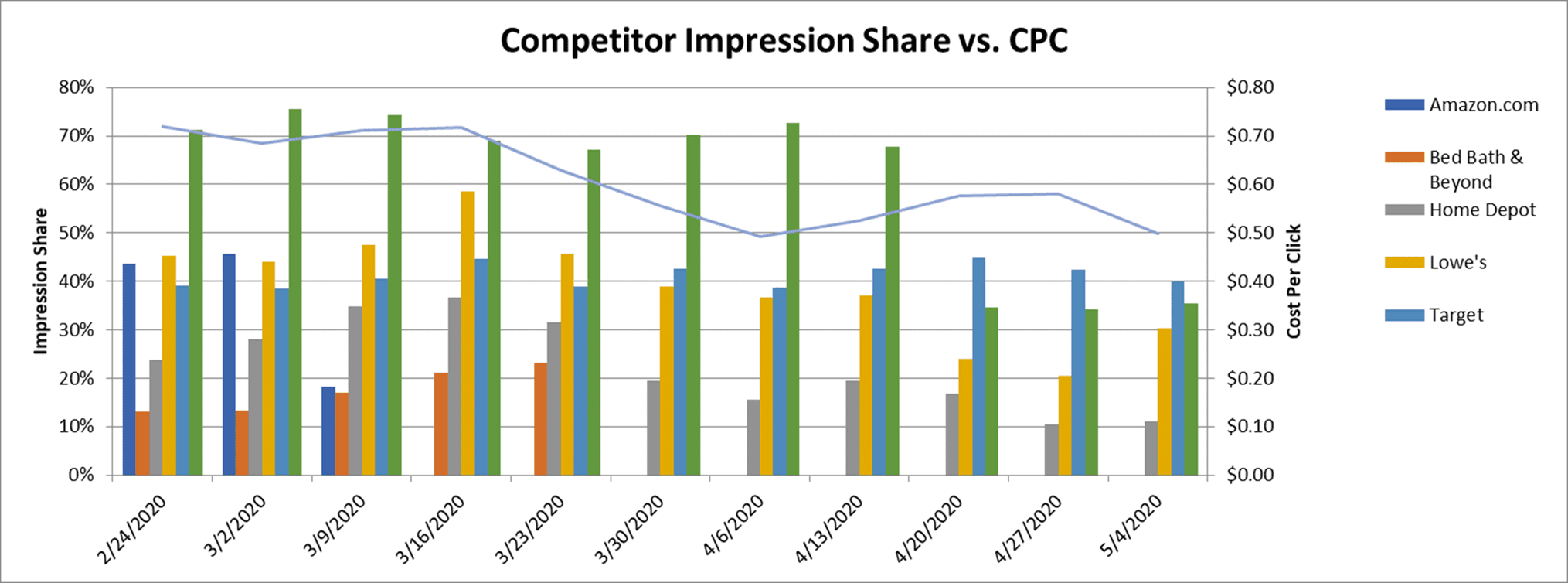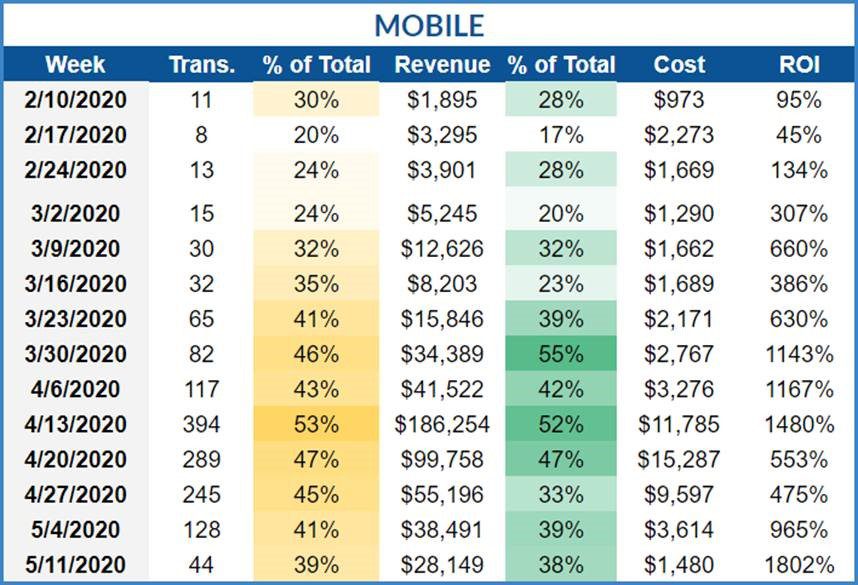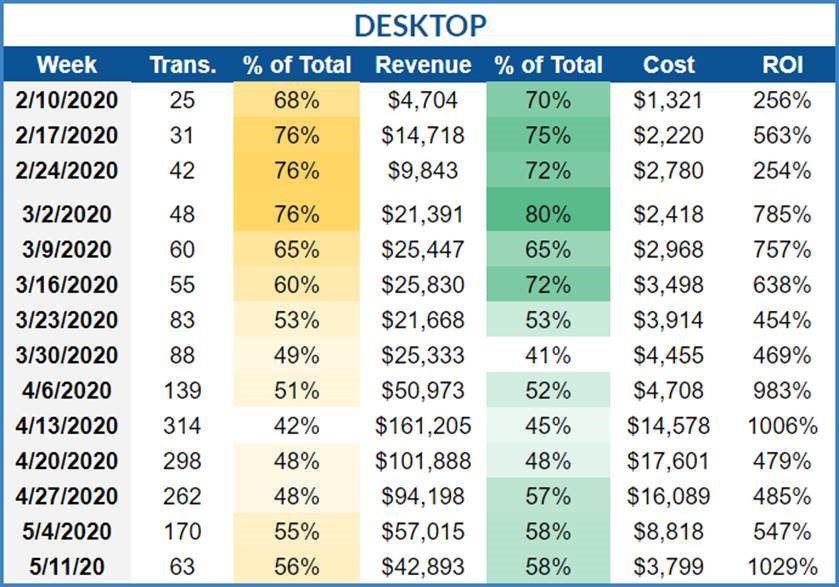If you’ve been acclimated with Google Ads and Microsoft Ads for the last 10 weeks or longer, you’ve likely noticed COVID-19’s impact on ecommerce search interests, buyer habits, and overall performance, regardless of industry.
In the initial weeks of the unprecedented stay-at-home mandates, marketers felt like they were on shaky ground. The closings of brick-and-mortar stores presented an opportunity for digital commerce, but the rising unemployment rate created uncertainty in whether or not commercial and consumer product sales would come to a screeching halt.
After a couple of weeks, it became clear that consumers were depending more on ecommerce than ever before for essential and non-essential items alike (everything from face masks and gloves to puzzles and children’s swing sets).
How can we expect paid search performance to be affected once daily consumer life has returned to a level of normalcy? It’s an answer that many advertisers would like to know!
We’ve compiled a short list of tips for making the most of the inevitable shift in competitive landscapes, buying behavior, and consumers’ renewed confidence in brick-and-mortar after the peak of lifestyle disruptions caused by coronavirus.
1. Stay Ahead of the Competitive Curve
Paid search trends during COVID-19 have helped demonstrate the risk-averse nature of businesses following the Great Recession in 2008.
At the onset of the shelter-in-place mantra, many advertisers greatly reduced their investment levels in Search and Shopping auctions or pulled out entirely, paving the way for those left behind to claim a larger share of the market. Additionally, you might have noticed Amazon’s decision to mostly remove Google Shopping ad placements upon its promise to stock only essential items in its fulfillment centers.
This jumpstarted widespread decreases in costs-per-click in early March. In this client’s impression share over time, we see Amazon waste away during the week of March 9, while our client’s average CPC was simultaneously reduced by $0.20 in a matter of two weeks.
Other big box competitors have showed volatility in our client’s space, as well:

For this reason, paid search marketers who were able to spend even a fraction of their normal budgets during this time likely saw increased click-through rates, sustained revenue, and a stronger ROAS than in previous periods. It was a great time to gain some serious ground toward their annual revenue goals!
With that said, we should be prepared for the other shoe to drop. Historically, Amazon has re-entered auctions with increased force to regain the level of impression share it claimed before – often at the cost of smaller retailers who find they’re spending more and making less.
If you reduced spend during COVID-19, phasing back into your normal budgets as soon as possible could help minimize the impact of increased CPCs when Amazon and other competitors return. If you applied more budget to capitalize on rising demand for your products, anticipate the higher spend levels that may be required to hold onto your current impression share!
2. Adapt Your Messaging and Increase the Incentive
During this sensitive time, it’s been increasingly important to practice “softer” calls to action in our ad messaging – think “we’re in this together” instead of “buy our product now.” With this in mind, consider running longer-term promotions or free shipping offers to bolster click volume and set your ad apart from others.
If you can only provide promotional incentives for a short time, publish ad copy, extensions, and display ads in paused status to enable quickly when your PPC account starts to feel the pressure of increased ad depth and rising CPCs.
3. Know Your Devices
With more people spending time at home with work, home projects, or hobbies on the brain, we’ve seen an increase in searches and sales volume from mobile devices. The account shown below saw its percentage of total PPC transactions from mobile rise from around 24% in early March to around 45% in late April, while the same percentage for desktop decreased:


When (somewhat) normal work and school schedules resume, we could see this upward mobile trend revert, as employees go back to making B2B or personal purchases from their in-office desktops.
While it is a best practice to avoid limiting mobile traffic, as a majority of successful customer journeys now begin with a mobile search, it’s a good idea to keep an eye on device-level ROAS and adjust accordingly.
4. Fill Your Funnel Using Brand Awareness Strategies
Now is as good a time as any to wholeheartedly dive into YouTube, Google Display Network, or Microsoft Audience Network, for one of two reasons:
- Your PPC accounts are experiencing a period of above-target efficiency, leaving wiggle room in your ROAS to give non-direct response advertising a serious go.
- You’ve been spending less on paid search during COVID-19, cycling through your repeat customer base with minimum new user volume being generated; replenishing the top of the funnel is necessary, and can often be done at lower CPCs than in Search and Shopping.
Consider launching display campaigns targeting relevant in-market, affinity, or custom intent audiences to build awareness of your products to users who are more likely to engage with your site and/or convert. Better yet, take advantage of your YouTube Channel in order to give qualified users in various stages of the purchase process a virtual experience of your products.
A top-funnel strategy allows B2B businesses to remain top-of-mind for customers who aren’t purchasing right now. It also allows B2C businesses to spread their brand to new prospective customers before the competition swells back to its normal size (see above).
To sweeten the deal, here’s some exclusive data on YouTube shared with us by our partners at Google:
- 90% of people claim they discover new products on YouTube.
- Advertisers that run YouTube ads in addition to search ads see 8% higher conversion volume, 3% higher conversion rate, and 4% lower search CPA.
- During this increased time spent at home, people have learned to depend on YouTube more than ever to learn and connect.
These times are unprecedented to say the least, but capitalizing on opportunities to maintain visibility and profitability in the long run will set the stage for a strong customer base during the ups and downs of COVID-19’s aftermath.
You can view all of our COVID-19 & ecommerce content here:
- [Video Replay] Looking Beyond the Pandemic: How to Thrive – Not Just Survive – in a New Ecommerce World
- Facebook Advertising Strategies During COVID-19
- How Coronavirus Is Impacting Ecommerce
- COVID-19 and Ecommerce: Amazon, Paid Search & Social, and Industry Impacts
- COVID-19 Supply Chain Disruption: Amazon and Beyond
- Amazon Vine Suspended in Response to COVID-19 & Supply Chain Disruptions
- April 2020 Industry Updates: Amazon’s Coronavirus Journey & Mobile’s Decline
- SEO Checklist for COVID-19
- Ecommerce Brands Helping During COVID-19
- [Infographic] COVID-19 in Q1: The Impacts of Coronavirus on Ecommerce
- Conversion Optimization During COVID-19
- [Video Replay] Paid Search Trends in the Coronavirus Climate
- [Video Replay] COVID-19, Ecommerce, and Your Brand



